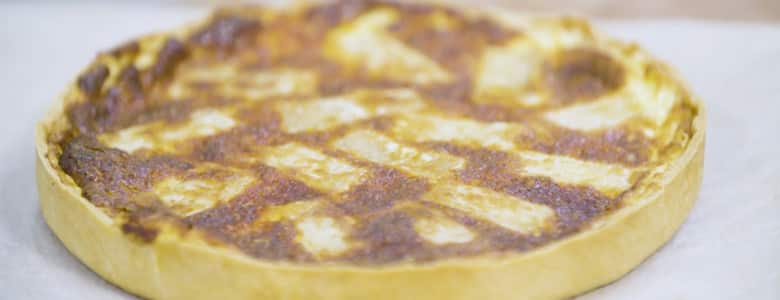Comté cheese and chard tart by Raymond Blanc
| Serves: 8 | Category: Tarts & pastries | Course: Main | Chef: Raymond Blanc | Machines: Mixer, Stand mixer, Mixer Attachments | Total time (min.): 1 hour 50 |


Ingredients
For the shortcrust pastry
- 200g plain flour
- 100g unsalted butter, diced, at room temperature
- 1 pinch of sea salt
- 1 organic/free-range medium egg
- 1 tbsp cold water
For the filling
- 30g unsalted butter
- 2 medium Swiss chard stalks (200g), cut into 2cm batons
- 60ml water
- sea salt and freshly ground black pepper
- 2 organic/free-range medium eggs
- 100ml whole milk
- 100ml whipping cream
- 200g Comté cheese, grated
Planning ahead: The pastry case can be prepared and rolled a day in advance and kept in the fridge.
Tools
- 21cm tart ring (2.5cm high)
- Baking stone (optional)
- Peel (optional)
- Kenwood’s K beater
Method
To make the pastry
- In the mixing bowl of your Kenwood machine, place the flour, butter and salt. Attach the K beater and mix on speed 1 for one minute until you have a sandy texture (*see note 1 below). Add the egg, water and continue to mix on speed one for 30 seconds until the mixture starts to come together into a smooth ball (*see note 2 below).
- Turn onto a lightly floured surface and knead gently with your palms for just 10 seconds. Break off 20-30g of dough, tightly wrap in cling film and refrigerate for later (to tuck in the dough). Flatten the remaining dough into a round, 2cm thick (*see note 3 below), and wrap in cling film. Refrigerate for 20–30 minutes before rolling out.
- Place the dough middle of a large sheet of cling film, cover with another sheet of cling film and roll out into a circle, 3mm thick (*see note 4 below).
- Place the tart ring on a baker’s peel or a tray lined with greaseproof paper. Remove the top layer of cling film and discard, then lift the dough by picking up the corners of the cling film and place it into the tart ring. Carefully fold the pastry into the ring with your fingers and tuck the dough into the edges using the little ball of reserved dough, moulding into the shape of the ring. Trim the edges of the tart with a knife and gently thin the edge of the tart by pressing your index finger and thumb all around the inside of the tart ring, to raise the edge 2mm above the ring (*see note 5 below). With a fork, lightly prick the bottom of the pastry case, line with a sheet of greaseproof paper and fill with baking beans (*see note 6 below).
- Place the tart case in the fridge for 30 minutes to relax and firm up the pastry (*see note 7 below).
- Preheat the oven to 170°C/Gas 3 with an oven tray on the middle shelf.
- Place the pastry case directly onto the pre-heated baking tray and blind bake for 25 minutes. Remove from the oven and leave to cool. Reserve the baking beans and greaseproof paper for future use.
- In a medium saucepan over a medium low heat, melt the butter, then add the chard batons, water and a little seasoning. Cover with a lid and cook gently for 10 minutes until the chard is soft, but still holding its shape.
- Drain and reserve.
- In a large bowl, mix together the eggs, milk and cream and season with salt and pepper. Scatter the chard pieces evenly over the base of the tart case.
- Slide the tart directly onto the baking tray in the oven and gently pour in the creamy egg mixture. Sprinkle the grated cheese over the top and bake for 20-25 minutes until lightly souffléd and golden brown. Leave to rest and cool slightly for 10 minutes before serving.
Variation
- In place of the chard, you could use leeks, spinach, sautéed mushrooms, partly cooked pumpkin.
——————————————————————————
Chef’s notes:
*1 For a successful pastry you need to have even distribution of butter within the flour, to give it flakiness. This is difficult to achieve if the butter is cold, so make sure it is at room temperature. Rub in delicately with your fingertips; do not try to knead at this stage.
*2 It is for you to judge the consistency of the dough. If it is too wet add a little flour; if too dry, add a little water. Flours differ in absorbency.
*3 Flattening the dough before resting it in the fridge is much easier to do than once it is chilled. Resting makes the dough less elastic, more pliable and easier to roll. It also minimises shrinkage in the oven.
*4 Rolling the pastry between cling film is a great little secret. It makes life much easier as you can dispense with flour, which will make your pastry heavier; your work top will be cleaner; and you overcome the problem of sticking when you roll out the dough in a warm kitchen.
*5 By pushing the edge of the tart to 2mm above the ring, you are compensating for any slight retraction of the pastry during cooking.
*6 Pricking the base of the tart case allows the steam generated during cooking to escape, helping to keep the case flat and level.
*7 Allow the pastry to rest before you cook it, to minimise any shrinkage.